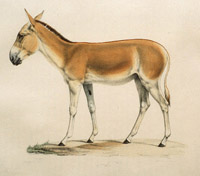
Erforschung biologischer Ressourcen der Mongolei / Exploration into the Biological Resources of Mongolia, ISSN 0440-1298
Date of this Version
2007
Document Type
Article
Citation
Erforschung biologischer Ressourcen der Mongolei (2007) band 10: 253-259.
Abstract
The onager, Equus hemionus onager, an Asiatic wild ass endemic to Iran, is categorized as Critically Endangered on the IUCN Red List. Its biology and conservation requirements are poorly documented. We report some observations made in 1997 and 2000 on the behavior and ecology of the two remaining populations, located in the Touran Protected Area and the Bahram-e-Goor Reserve. Recent population counts by the Department of Environment of Iran (471 in the Protected Area, and 96 in the Reserve) are markedly lower than the count of 600-770 made in the 1970s in the Touran Protected Area. We observed social interactions between stallions and mares outside the breeding season which contrast to the known social structure of this Persian subspecies. Poaching, competitions with domestic animals, removal of shrubs for domestic use, and land conversion have been identified as the main threats to the two remaining onager populations. In addition, geographical isolation could cause the loss of genetic variability in these two relatively small populations, and also makes them more susceptible to the potential effects of stochastic events such as drought or disease. Public awareness, protection, and scientific studies in Iran must be urgently supported by both national and international organizations in order to prevent the extinction of these two apparently dwindling populations of onager.
Included in
Asian Studies Commons, Biodiversity Commons, Environmental Sciences Commons, Nature and Society Relations Commons, Other Animal Sciences Commons, Population Biology Commons, Terrestrial and Aquatic Ecology Commons, Zoology Commons


Comments
Copyright 2007, Martin-Luther-Universität Halle Wittenberg, Halle (Saale). Used by permission.